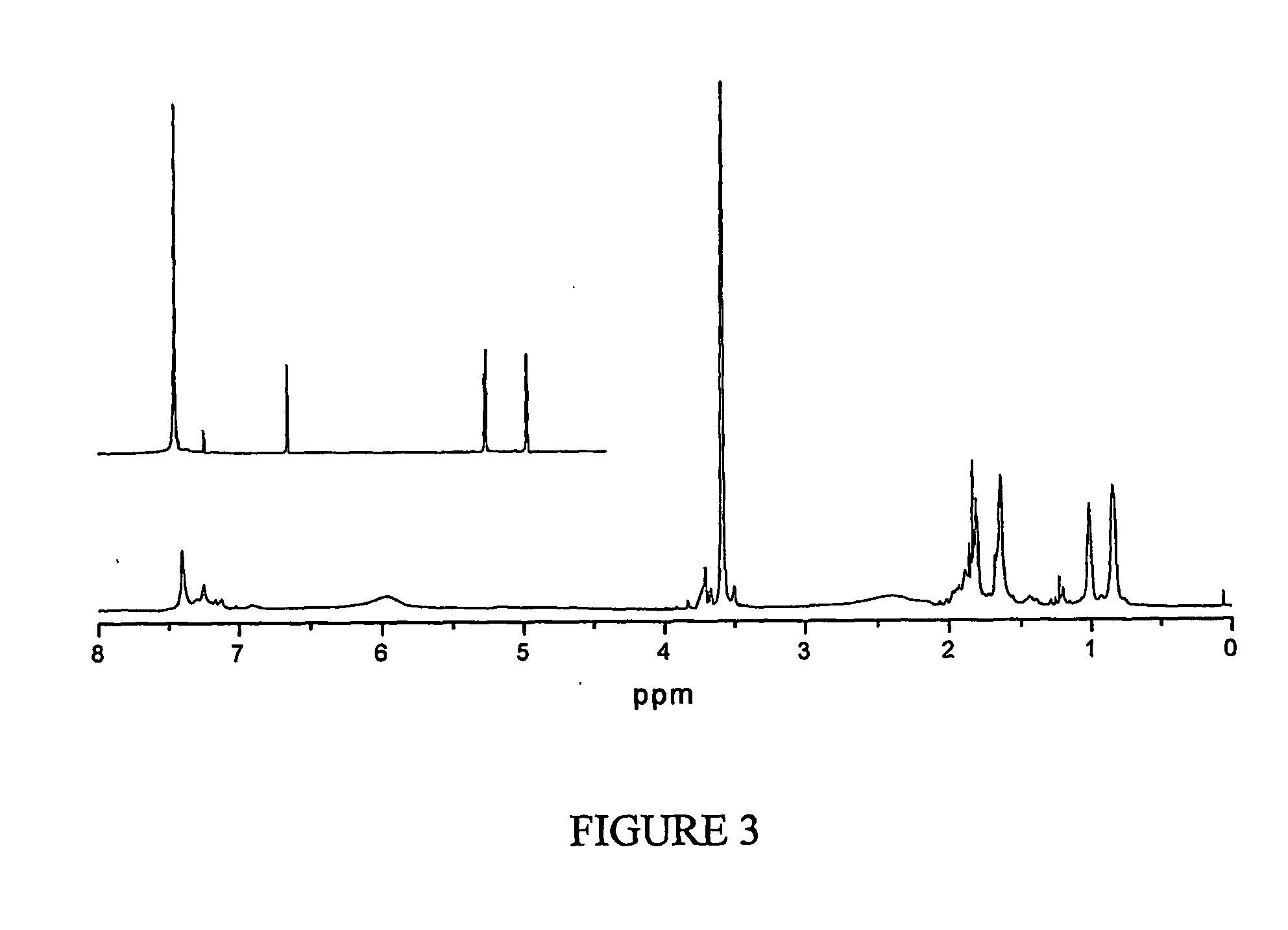Degradable polymers
a technology of degradable polymers and polymers, applied in the field of degradable polymers, can solve the problems of difficult copolymerization with conventional vinyl monomers, low levels of cyclic ketene acetal, and inability to control the molecular weight of the resulting (co)polymers,
- Summary
- Abstract
- Description
- Claims
- Application Information
AI Technical Summary
Benefits of technology
Problems solved by technology
Method used
Image
Examples
example 1
Degradable Linear (Homo)Polymers by ATRP / RROP Copolymerization
[0111] A degradable poly(methyl methacrylate), with low polydispersity index, was synthesized by copolymerization of methyl methacrylate (MMA) and 5-methylene-2-phenyl-1,3-dioxan-4-one (MPDO) by atom transfer radical polymerization (ATRP); FIG. 1. The number average molecular weights of the polymers measured by GPC matched well with the theoretical values (Mn≈15,000 g / mol), and the polydispersity indexes were in the range of Mw / Mn=1.2-1.3; FIG. 2. 1H NMR data shows that MPDO is successfully incorporated into the copolymers with a completely ring-opened structure; FIG. 3. The linear semi-logarithmic kinetic plots for consumption of MPDO and MMA indicated a constant concentration of the growing radicals during the copolymerization and the rate of incorporation of MPDO and MMA into the copolymer was the same regardless of the polymerization temperature or monomer feed ratio, under typical ATRP conditions.
[0112] After eithe...
example 2
Synthesis of Degradable Polystyrene via CRP
[0128] The most obvious need for degradable polystyrene might be envisioned to be a photo-degradable polymer that would reduce the level / impact of foamed polystyrene packaging material in the visual environment However, the incorporation of photo-degradability into polystyrene was not sufficient to induce the market to move to such a material to reduce the litter problem in the mid-70's. The reason was that majority of the discarded material became dirty, ended up in the shade, or was partially buried; thereby reducing the level of incident light on the material and, hence, the degradability of the polymer. A degradable polystyrene, such as a material with dual degradation mechanisms, would circumvent this problem as the polymer would degrade in the sunlight or in shade.
[0129] While we will be describing the preparation of the target material by a CRP, exemplified by ATRP, any polymerization process can be employed if less control is acce...
example 5
Direct Incorporation of Captodative Monomers
[0159] a. Ethyl (1-ethoxycarbonyl)vinyl phosphate was prepared in 84% yield by treating ethyl bromopyruvate with trimethyl phosphite (Scheme 16). [Barton, D. H. R.; Chern, C. Y.; Jaszberenyi, J. C. Tetrahedron 1995, 51, 1867.]
[0160] b. Ethyl α-trimethylsiloxyacrylate was prepared in 88% yield by a one-step procedure starting from methyl pyruvate and trimethylsilyl chloride (Scheme 17). [Creary, X.; Inocencio, P. A.; Underiner, T. L.; Kostromin, R. J. Org. Chem. 1985, 50, 1932.]
[0161] c. Polymerization:
[0162] Initial experiments to conduct the polymerization of methyl α-trimethylsiloxyacrylate and dimethyl (1-ethoxycarbonyl)vinyl phosphate at 70° C. employed a standard ATRP method. The reaction conditions follow: Initiator is ethyl 2-bromoisobutyrate, catalyst is CuBr / CuBr2(5%) / PMDETA. [Initiator]: [CuBr]: [CuBr2]: [PMDETA]: [Monomer]=1:1:0.05:1.05:200. But methyl α-trimethylsiloxyacrylate and dimethyl (1-ethoxycarbonyl)vinyl phosphate bo...
PUM
| Property | Measurement | Unit |
|---|---|---|
| molecular weight distribution | aaaaa | aaaaa |
| molecular weight distribution | aaaaa | aaaaa |
| molecular weight distribution | aaaaa | aaaaa |
Abstract
Description
Claims
Application Information
 Login to View More
Login to View More - R&D
- Intellectual Property
- Life Sciences
- Materials
- Tech Scout
- Unparalleled Data Quality
- Higher Quality Content
- 60% Fewer Hallucinations
Browse by: Latest US Patents, China's latest patents, Technical Efficacy Thesaurus, Application Domain, Technology Topic, Popular Technical Reports.
© 2025 PatSnap. All rights reserved.Legal|Privacy policy|Modern Slavery Act Transparency Statement|Sitemap|About US| Contact US: help@patsnap.com



